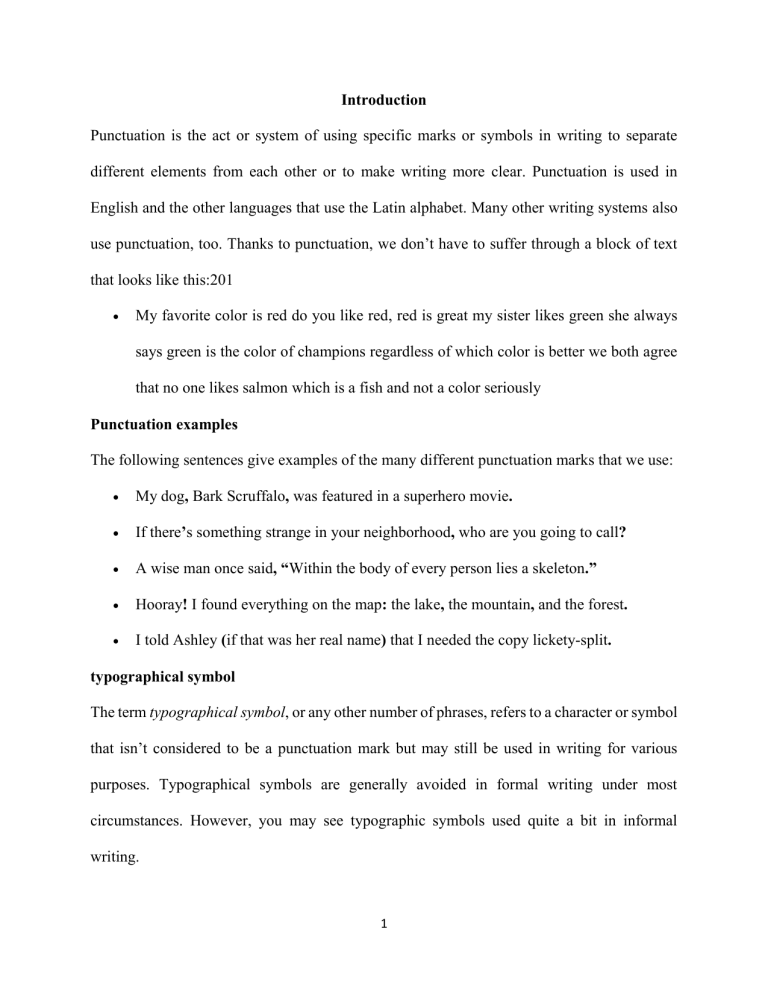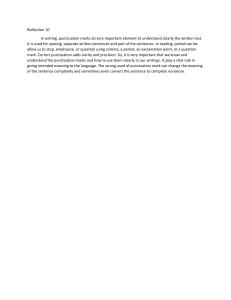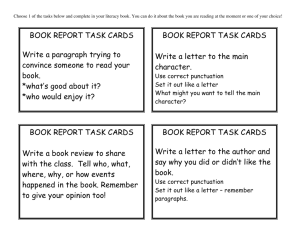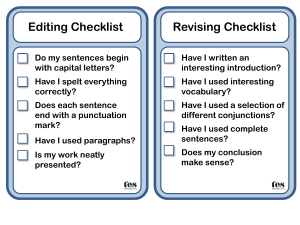
Introduction
Punctuation is the act or system of using specific marks or symbols in writing to separate
different elements from each other or to make writing more clear. Punctuation is used in
English and the other languages that use the Latin alphabet. Many other writing systems also
use punctuation, too. Thanks to punctuation, we don’t have to suffer through a block of text
that looks like this:201
My favorite color is red do you like red, red is great my sister likes green she always
says green is the color of champions regardless of which color is better we both agree
that no one likes salmon which is a fish and not a color seriously
Punctuation examples
The following sentences give examples of the many different punctuation marks that we use:
My dog, Bark Scruffalo, was featured in a superhero movie.
If there’s something strange in your neighborhood, who are you going to call?
A wise man once said, “Within the body of every person lies a skeleton.”
Hooray! I found everything on the map: the lake, the mountain, and the forest.
I told Ashley (if that was her real name) that I needed the copy lickety-split.
typographical symbol
The term typographical symbol, or any other number of phrases, refers to a character or symbol
that isn’t considered to be a punctuation mark but may still be used in writing for various
purposes. Typographical symbols are generally avoided in formal writing under most
circumstances. However, you may see typographic symbols used quite a bit in informal
writing.
1
Typographical symbol examples
The following examples show some ways that a writer might use typographical symbols. Keep
in mind that some of these sentences may not be considered appropriate in formal writing.
The frustrated actor said she was tired of her co-star’s “annoying bull****.”
For questions, email us at anascabana@bananacabanas.fake!
The band had five #1 singles on the American music charts during the 1990s.
My internet provider is AT&T.
Punctuation vs. typographical symbols
Punctuation marks are considered part of grammar and often have well-established rules for
how to use them properly. For example, the rules of proper grammar state that a letter after a
period should be capitalized and that a comma must be used before a coordinating conjunction.
Typographical symbols, on the other hand, may not have widely accepted rules for how, or
even when, they should be used. Generally speaking, most grammar resources will only allow
the use of typographical symbols under very specific circumstances and will otherwise advise
a writer to avoid using them.
Types of punctuation and symbols
There are many different types of punctuation marks and typographical symbols. We’ll briefly
touch on them now, but you can learn more about of these characters by checking out the links
in this list and also each section below:
1. Period
2. Question mark
3. Exclamation point
2
4. Comma
5. Colon
6. Semicolon
7. Hyphen
8. En dash
9. Em dash
10. Parentheses
11. Square brackets
12. Curly brackets
13. Angle brackets
14. Quotation marks
15. Apostrophe
16. Slash
17. Ellipses
18. Asterisk
19. Ampersand
20. Bullet point
21. Pound symbol
22. Tilde
23. Backslash
24. At symbol
25. Caret symbol
26. Pipe symbol
3
Period, question mark, and exclamation point
These three commonly used punctuation marks are used for the same reason: to end an
independent thought.
Period (.)
A period is used to end a declarative sentence. A period indicates that a sentence is finished.
Today is Friday.
Unique to them, periods are also often used in abbreviations.
Prof. Dumbledore once again awarded a ludicrous amount of points to Gryffindor.
Question mark (?)
The question mark is used to end a question, also known as an interrogative sentence.
Do you feel lucky?
Exclamation point (!)
The exclamation point is used at the end of exclamations and interjections.
Our house is haunted!
Wow!
Comma, colon, and semicolon
Commas, colons, and semicolons can all be used to connect sentences together.
Comma (,)
The comma is often the punctuation mark that gives writers the most problems. It has many
different uses and often requires good knowledge of grammar to avoid making mistakes when
using it. Some common uses of the comma include:
Joining clauses: Mario loves Peach, and she loves him.
4
Nonrestrictive elements: My favorite team, the Fighting Mongooses, won the
championship this year.
Lists: The flag was red, white, and blue.
Coordinate adjectives: The cute, happy puppy licked my hand.
Try out this quiz on the Oxford comma!
Colon (:)
The colon is typically used to introduce additional information.
The detective had three suspects: the salesman, the gardener, and the lawyer.
Like commas, colons can also connect clauses together.
We forgot to ask the most important question: who was buying lunch?
Colons have a few other uses, too.
The meeting starts at 8:15 p.m.
The priest started reading from Mark 3:6.
Semicolon (;)
Like the comma and the colon, the semicolon is used to connect sentences together. The
semicolon typically indicates that the second sentence is closely related to the one before it.
I can’t eat peanuts; I am highly allergic to them.
Lucy loves to eat all kinds of sweets; lollipops are her favorite.
Hyphen and dashes (en dash and em dash)
All three of these punctuation marks are often referred to as “dashes.” However, they are all
used for entirely different reasons.
Hyphen (-)
The hyphen is used to form compound words.
5
I went to lunch with my father-in-law.
She was playing with a jack-in-the-box.
He was accused of having pro-British sympathies.
En dash (–)
The en dash is used to express ranges or is sometimes used in more complex compound words.
The homework exercises are on pages 20–27.
The songwriter had worked on many Tony Award–winning productions.
Em dash (—)
The em dash is used to indicate a pause or interrupted speech.
The thief was someone nobody expected—me!
“Those kids will—” was all he managed to say before he was hit by a water balloon.
Parentheses, brackets, and braces
These pairs of punctuation marks look similar, but they all have different uses. In general, the
parentheses are much more commonly used than the others.
Parentheses ()
Typically, parentheses are used to add additional information.
I thought (for a very long time) if I should actually give an honest answer.
Tomorrow is Christmas (my favorite holiday)!
Parentheses have a variety of other uses, too.
Pollution increased significantly. (See Chart 14B)
He was at an Alcoholics Anonymous (AA) meeting.
Richard I of England (1157–1199) had the heart of a lion.
Square brackets []
6
Typically, square brackets are used to clarify or add information to quotations.
According to an eyewitness, the chimpanzees “climbed on the roof and juggled
[bananas].”
The judge said that “the defense attorney [Mr. Wright] had made it clear that the case
was far from closed.”
Curly brackets {}
Curly brackets, also known as braces, are rarely used punctuation marks that are used to group
a set.
I was impressed by the many different colors {red, green, yellow, blue, purple, black,
white} they selected for the flag’s design.
Angle brackets <>
Angle brackets have no usage in formal writing and are rarely ever used even in informal
writing. These characters have more uses in other fields, such as math or computing.
Quotation marks and apostrophe
You’ll find these punctuation marks hanging out at the top of a line of text.
Quotation marks (“”)
The most common use of quotation marks is to contain quotations.
She said, “Don’t let the dog out of the house.”
Bob Ross liked to put “happy little trees” in many of his paintings.
Apostrophe (‘)
The apostrophe is most often used to form possessives and contractions.
The house’s back door is open.
My cousin’s birthday is next week.
7
It isn’t ready yet.
We should’ve stayed outside.
Slash and ellipses
These are two punctuation marks you may not see too often, but they are still useful.
Slash (/)
The slash has several different uses. Here are some examples:
Relationships: The existence of boxer briefs somehow hasn’t ended the boxers/briefs
debate.
Alternatives: They accept cash and/or credit.
Fractions: After an hour, 2/3 of the audience had already left.
Ellipses (…)
In formal writing, ellipses are used to indicate that words were removed from a quote.
The mayor said, “The damages will be … paid for by the city … as soon as possible.”
In informal writing, ellipses are often used to indicate pauses or speech that trails off.
He nervously stammered and said, “Look, I … You see … I wasn’t … Forget it, okay.”
Make Your Writing Shine!
Get grammar tips, writing tricks, and more from Thesaurus.com ... right in your inbox!
Typographical symbols
Typographical symbols rarely appear in formal writing. You are much more likely to see them
used for a variety of reasons in informal writing.
Asterisk (*)
In formal writing, especially academic and scientific writing, the asterisk is used to indicate a
footnote.
8
Chocolate is the preferred flavor of ice cream.*
According to survey data from the Ice Cream Data Center.
The asterisk may also be used to direct a reader toward a clarification or may be used to censor
inappropriate words or phrases.
Ampersand (&)
The ampersand substitutes for the word and. Besides its use in the official names of things,
the ampersand is typically avoided in formal writing.
The band gave a speech at the Rock & Roll Hall of Fame.
Bullet Point (•)
Bullet points are used to create lists. For example,
For this recipe you will need:
eggs
milk
sugar
flour
baking powder
Pound symbol (#)
Informally, the pound symbol is typically used to mean number or is used in social media
hashtags.
The catchy pop song reached #1 on the charts.
Ready 4 Halloween 2morrow!!! #spooky #TrickorTreat
9
Tilde (~)
Besides being used as an accent mark in Spanish and Portuguese words, the tilde is rarely used.
Informally, a person may use it to mean “about” or “approximately.”
We visited São Paulo during our vacation.
I think my dog weighs ~20 pounds.
Backslash (\)
The backslash is primarily used in computer programming and coding. It might be used online
and in texting to draw emoticons, but it has no other common uses in writing. Be careful not
to mix it up with the similar forward slash (/), which is a punctuation mark.
At symbol (@)
The at symbol substitutes for the word at in informal writing. In formal writing, it is used when
writing email addresses.
His email address is duckduck@goose.abc.
Caret symbol (^)
The caret symbol is used in proofreading, but may be used to indicate an exponent if a writer
is unable to use superscript.
Do you know what 3^4 (34) is equal to?
Pipe symbol (|)
The pipe symbol is not used in writing. Instead, it has a variety of functions in the fields of
math, physics, or computing.
Conclusion
In writing, the correct use of punctuation marks is an important technique used by writers to convey
meaning in a clear and simple way. In this research, the most widely used punctuation marks in
10
writing have been discussed with examples. The aims of the are to investigate the errors made by
students their performance of punctuation marks, and to identify the most difficult types of them
on the part of the students/subjects under investigation.
11


